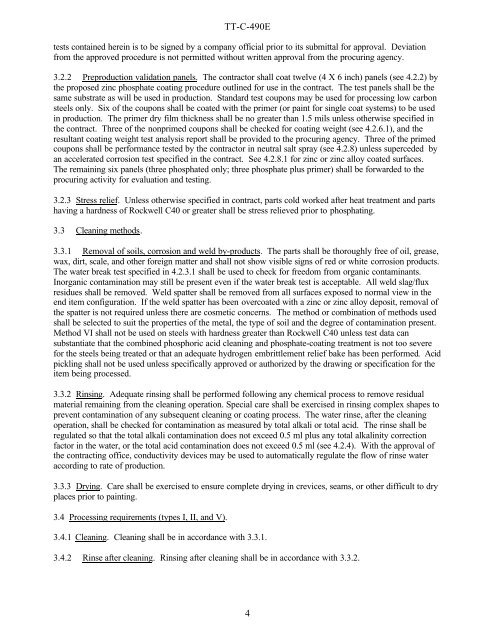TT-C-490E Chemical Conversion Coatings and Pretreatments for ...
TT-C-490E Chemical Conversion Coatings and Pretreatments for ...
TT-C-490E Chemical Conversion Coatings and Pretreatments for ...
Create successful ePaper yourself
Turn your PDF publications into a flip-book with our unique Google optimized e-Paper software.
<strong>TT</strong>-C-<strong>490E</strong><br />
tests contained herein is to be signed by a company official prior to its submittal <strong>for</strong> approval. Deviation<br />
from the approved procedure is not permitted without written approval from the procuring agency.<br />
3.2.2 Preproduction validation panels. The contractor shall coat twelve (4 X 6 inch) panels (see 4.2.2) by<br />
the proposed zinc phosphate coating procedure outlined <strong>for</strong> use in the contract. The test panels shall be the<br />
same substrate as will be used in production. St<strong>and</strong>ard test coupons may be used <strong>for</strong> processing low carbon<br />
steels only. Six of the coupons shall be coated with the primer (or paint <strong>for</strong> single coat systems) to be used<br />
in production. The primer dry film thickness shall be no greater than 1.5 mils unless otherwise specified in<br />
the contract. Three of the nonprimed coupons shall be checked <strong>for</strong> coating weight (see 4.2.6.1), <strong>and</strong> the<br />
resultant coating weight test analysis report shall be provided to the procuring agency. Three of the primed<br />
coupons shall be per<strong>for</strong>mance tested by the contractor in neutral salt spray (see 4.2.8) unless superceded by<br />
an accelerated corrosion test specified in the contract. See 4.2.8.1 <strong>for</strong> zinc or zinc alloy coated surfaces.<br />
The remaining six panels (three phosphated only; three phosphate plus primer) shall be <strong>for</strong>warded to the<br />
procuring activity <strong>for</strong> evaluation <strong>and</strong> testing.<br />
3.2.3 Stress relief. Unless otherwise specified in contract, parts cold worked after heat treatment <strong>and</strong> parts<br />
having a hardness of Rockwell C40 or greater shall be stress relieved prior to phosphating.<br />
3.3 Cleaning methods.<br />
3.3.1 Removal of soils, corrosion <strong>and</strong> weld by-products. The parts shall be thoroughly free of oil, grease,<br />
wax, dirt, scale, <strong>and</strong> other <strong>for</strong>eign matter <strong>and</strong> shall not show visible signs of red or white corrosion products.<br />
The water break test specified in 4.2.3.1 shall be used to check <strong>for</strong> freedom from organic contaminants.<br />
Inorganic contamination may still be present even if the water break test is acceptable. All weld slag/flux<br />
residues shall be removed. Weld spatter shall be removed from all surfaces exposed to normal view in the<br />
end item configuration. If the weld spatter has been overcoated with a zinc or zinc alloy deposit, removal of<br />
the spatter is not required unless there are cosmetic concerns. The method or combination of methods used<br />
shall be selected to suit the properties of the metal, the type of soil <strong>and</strong> the degree of contamination present.<br />
Method VI shall not be used on steels with hardness greater than Rockwell C40 unless test data can<br />
substantiate that the combined phosphoric acid cleaning <strong>and</strong> phosphate-coating treatment is not too severe<br />
<strong>for</strong> the steels being treated or that an adequate hydrogen embrittlement relief bake has been per<strong>for</strong>med. Acid<br />
pickling shall not be used unless specifically approved or authorized by the drawing or specification <strong>for</strong> the<br />
item being processed.<br />
3.3.2 Rinsing. Adequate rinsing shall be per<strong>for</strong>med following any chemical process to remove residual<br />
material remaining from the cleaning operation. Special care shall be exercised in rinsing complex shapes to<br />
prevent contamination of any subsequent cleaning or coating process. The water rinse, after the cleaning<br />
operation, shall be checked <strong>for</strong> contamination as measured by total alkali or total acid. The rinse shall be<br />
regulated so that the total alkali contamination does not exceed 0.5 ml plus any total alkalinity correction<br />
factor in the water, or the total acid contamination does not exceed 0.5 ml (see 4.2.4). With the approval of<br />
the contracting office, conductivity devices may be used to automatically regulate the flow of rinse water<br />
according to rate of production.<br />
3.3.3 Drying. Care shall be exercised to ensure complete drying in crevices, seams, or other difficult to dry<br />
places prior to painting.<br />
3.4 Processing requirements (types I, II, <strong>and</strong> V).<br />
3.4.1 Cleaning. Cleaning shall be in accordance with 3.3.1.<br />
3.4.2 Rinse after cleaning. Rinsing after cleaning shall be in accordance with 3.3.2.<br />
4

















